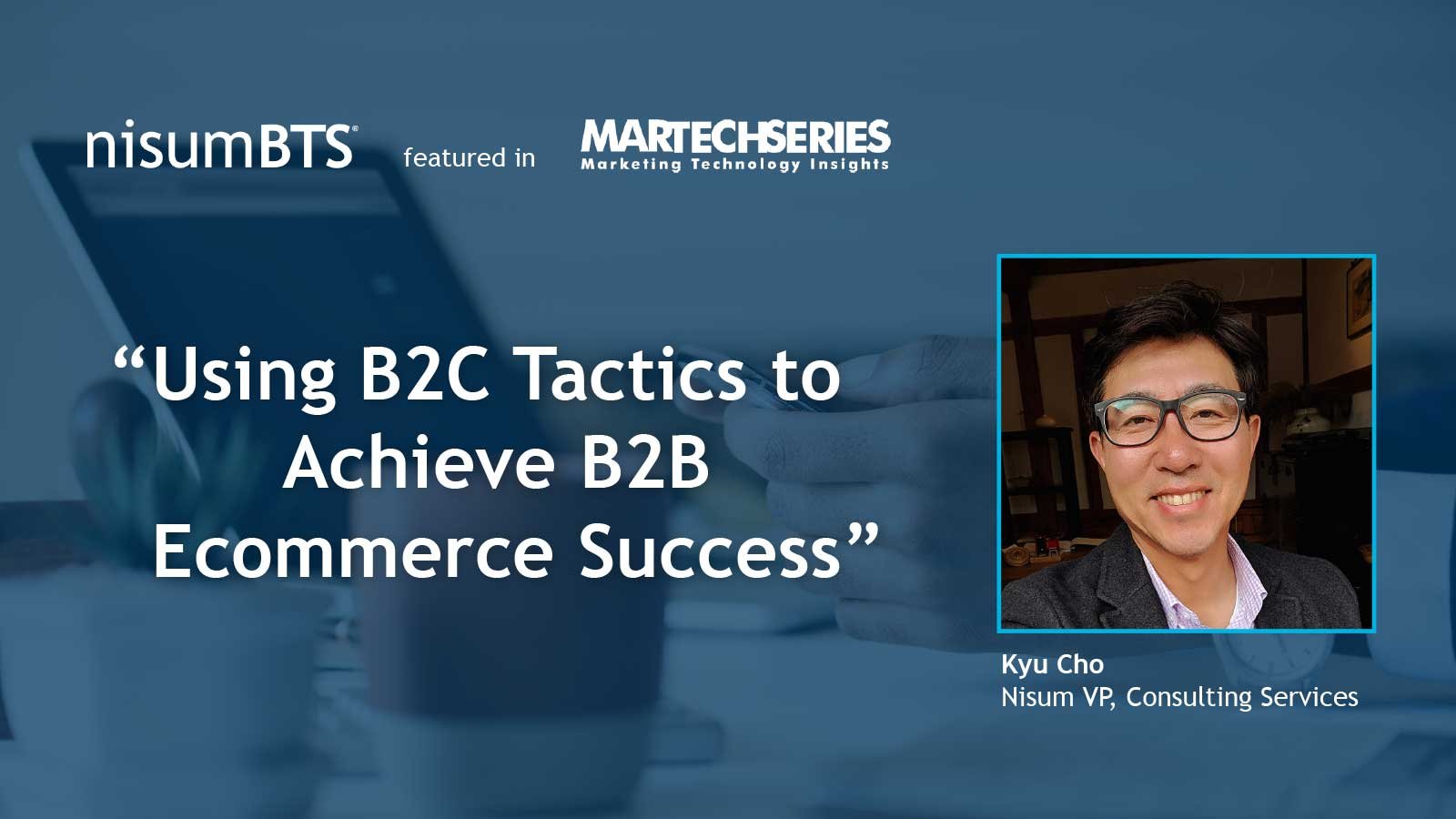Nisum VP, Kyu Cho, talks about why omnichannel strategies are becoming a necessity for B2B businesses in a MarTech article. Read the full text below or see the full article here.

Using B2C Tactics to Achieve B2B eCommerce Success
On Monday, July 17 (or Prime Day, depending on whom you ask) Amazon’s stock hit a new all-time high, making Jeff Bezos the richest man in the world worth more than $150 billion. This is certainly significant, but not entirely surprising given B2C eCommerce’s massive growth; in 2017, online retail sales worldwide reached $2.3 trillion, a nearly 25% increase over the previous year.
Less celebrated, but no less noteworthy, is the even more rampant growth of B2B eCommerce. While B2C eCommerce sales closed in 2017 at $2.3 trillion worldwide, B2B eCommerce reached $7.7 trillion — a 234.78% difference in market size. With B2B eCommerce poised for such extreme growth, why do we not hear more about it?
It’s true that B2C eCommerce has attracted most of the attention and investment from the technology and business communities. This is because, in order to compete in a dynamic retail market and “catch up” to tech leaders like Amazon, traditional B2C retailers are investing lots of resources to revamp their own tech offerings, roll out new features and otherwise create new ways to market and sell their products. Those B2C retailers who have committed to new technologies and processes continue to thrive. Those who have not to struggle for their survival.
B2B is a different story. Many successful B2B businesses have continued to prosper without as much investment in omnichannel eCommerce as their B2C counterparts, but the landscape is quickly changing.
B2B businesses could be leaving a massive amount of revenue on the table by not investing in the eCommerce offerings that have become table stakes for B2C companies. Sophisticated eCommerce capabilities allow B2B organizations to maximize the potential of digital channels, segment and personalize according to any number of variables with better accuracy, maximize inventory turnover, cross and up-sell additional products, and improve the quality of buyer experience with faster, more seamless transactions.
Similarly, as business processes and technology continue to evolve, this too changes customer behavior and expectations, and in turn, how organizations do business. Remember, your B2B customers are also consumers in the B2C space; they’re used to sophisticated buying experiences and will start looking for that same level of service and experience in the B2B space.
As the market for B2B eCommerce grows, there are some key business processes and technology improvements that B2B organizations should begin implementing in order to stand out, maximize revenue, and improve operational efficiency.
To Drive Top Line Revenue Growth…
B2B customers are expecting a B2C grade experience across all channels. In addition to standard B2C eCommerce practices like loyalty programs, social media marketing, a great looking website that focuses on customer experience, and the ability to cross-promote/return/exchange items across online and in-store, B2B should also invest in the following:
- Flexible price negotiation – Knowing which discounts will convert which customers helps organizations drive maximum revenue. For example, customer A converts at 20% off, but customer B converts at 10%.
- Customizable product features – In the B2C world, customers can personalize everything from sneakers to phone cases online with a simple one-click interface. In B2B, customers must also be able to customize their product and service offerings easily to best suit their business needs.
- Simplified checkout – The fewer steps involved in the checkout process, the better. Once a customer has decided to purchase, a series of pages and redirects are not only frustrating but also give customers more opportunities to change their minds.
To Improve Operational Efficiencies...
On the backend, omnichannel investments can streamline business processes and cut costs. Here are some of the examples:
- Fulfillment from different warehouses and distribution centers – B2B sellers can maximize inventory turnover and cut shipping costs by fulfilling online customer orders using products at the nearest warehouses and distribution centers.
- CPQ user interfaces – Enabling online product and merchandise configurations, dynamic pricing, and quotation will require fewer sales representatives and/or customer service engagement. This will also improve customer experience by giving them access to the information they need 24/7.
- Online catalog and ordering process – The traditional practice of sending product catalog by mail or PDF and subsequent order capturing via phone or email or other paper requires time and effort from both the buyer and the seller and often leads to errors, corrections, and cancellations. By moving the process online, the companies will see improved sales cycle time and allow sales staff to focus more on identifying new customers and introducing products with a higher profit margin.
As many of the omnichannel capabilities pioneered by eCommerce leaders have simply become costs to entry in the B2C marketplace, consumers have come to expect this same seamless experience whether purchasing for personal or business purposes. To drive competitive advantage in crowded and growing space, B2B sellers are well-advised to adopt some of the winning strategies of their B2C counterparts.



